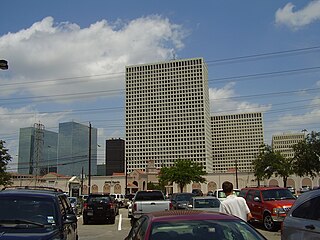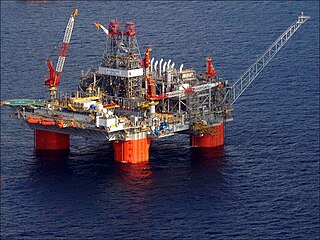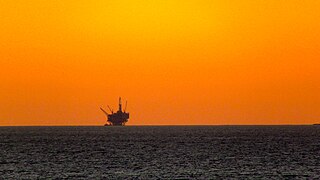
An oil platform is a large structure with facilities to extract and process petroleum and natural gas that lie in rock formations beneath the seabed. Many oil platforms will also have facilities to accommodate the workers, although it is also common to have a separate accommodation platform bridge linked to the production platform. Most commonly, oil platforms engage in activities on the continental shelf, though they can also be used in lakes, inshore waters, and inland seas. Depending on the circumstances, the platform may be fixed to the ocean floor, consist of an artificial island, or float. In some arrangements the main facility may have storage facilities for the processed oil. Remote subsea wells may also be connected to a platform by flow lines and by umbilical connections. These sub-sea facilities may include one or more subsea wells or manifold centres for multiple wells.
The Atlantis oil field is the third largest oil field in the Gulf of Mexico. The field was discovered in 1998 and is located at the Green Canyon blocks 699, 700, 742, 743, and 744 in United States federal waters in the Gulf of Mexico about 130 miles (210 km) from the coast of Louisiana. The oil field lies in water depths ranging from 4,400 to 7,100 feet. The subsea structure of Atlantis has long been the target of safety critics.

Transocean Ltd. is an American company. It is the world's largest offshore drilling contractor based on revenue and is based in Vernier, Switzerland. The company has offices in 20 countries, including Canada, the United States, Norway, United Kingdom, India, Brazil, Singapore, Indonesia, and Malaysia.

Thunder Horse oil field is a large offshore deepwater oil field in the Gulf of Mexico, around 150 miles (240 km) southeast of New Orleans, Louisiana. Large new oil discoveries within it were announced in early 2019.

A drillship is a merchant vessel designed for use in exploratory offshore drilling of new oil and gas wells or for scientific drilling purposes. In recent years the vessels have been used in deepwater and ultra-deepwater applications, equipped with the latest and most advanced dynamic positioning systems.

A blowout is the uncontrolled release of crude oil and/or natural gas from an oil well or gas well after pressure control systems have failed. Modern wells have blowout preventers intended to prevent such an occurrence. An accidental spark during a blowout can lead to a catastrophic oil or gas fire.

Offshore drilling is a mechanical process where a wellbore is drilled below the seabed. It is typically carried out in order to explore for and subsequently extract petroleum that lies in rock formations beneath the seabed. Most commonly, the term is used to describe drilling activities on the continental shelf, though the term can also be applied to drilling in lakes, inshore waters and inland seas.

Deepwater Horizon was an ultra-deepwater, dynamically positioned, semi-submersible offshore drilling rig owned by Transocean and operated by BP. On 20 April 2010, while drilling at the Macondo Prospect, a blowout caused an explosion on the rig that killed 11 crewmen and ignited a fireball visible from 40 miles (64 km) away. The fire was inextinguishable and, two days later, on 22 April, the Horizon sank, leaving the well gushing at the seabed and causing the largest marine oil spill in history.
The Al Shaheen Oil Field is a production oil and gas field off the north east coast of Qatar in the Persian Gulf, 80 kilometres (50 mi) north of Doha. The oil field lies above the North Gas Field, one of the largest gas fields in the world. The field has been operated by Maersk Oil Qatar AS of Denmark until July 2017 under a production sharing agreement with QatarEnergy, on behalf of the state of Qatar. As of June 2016, QatarEnergy and the French major TotalEnergies established a new company known as North Oil Company. The new company is 70% owned by QatarEnergy and 30% by TotalEnergies. North Oil Company took over field operations on 14 July 2017.
Deepwater drilling, or deep well drilling, is the process of creating holes in the Earth's crust using a drilling rig for oil extraction under the deep sea. There are approximately 3400 deepwater wells in the Gulf of Mexico with depths greater than 150 meters.

The Tiber Oil Field is a deepwater offshore oil field located in the Keathley Canyon block 102 of the United States sector of the Gulf of Mexico. The deepwater field was discovered in September 2009 and it is operated by BP. Described as a "giant" find, it is estimated to contain 4 to 6 billion barrels of oil in place. Although BP states it is too early to be sure of the size – a "huge" field is usually considered to contain 250 million barrels. It required the drilling of a 10,685 m (35,056 ft) deep well under 1,260 m (4,130 ft) of water, making it one of the deepest wells ever drilled at the time of discovery.
The Macondo Prospect is an oil and gas prospect in the United States Exclusive Economic Zone of the Gulf of Mexico, off the coast of Louisiana. The prospect was the site of the Deepwater Horizon drilling rig explosion in April 2010 that led to a major oil spill in the region from the first exploration well, named itself MC252-1, which had been designed to investigate the existence of the prospect.

The Deepwater Horizon drilling rig explosion was an April 20, 2010 explosion and subsequent fire on the Deepwater Horizon semi-submersible mobile offshore drilling unit, which was owned and operated by Transocean and drilling for BP in the Macondo Prospect oil field about 40 miles (64 km) southeast off the Louisiana coast. The explosion and subsequent fire resulted in the sinking of the Deepwater Horizon and the deaths of 11 workers; 17 others were injured. The same blowout that caused the explosion also caused an oil well fire and a massive offshore oil spill in the Gulf of Mexico, considered the largest accidental marine oil spill in the world, and the largest environmental disaster in United States history.

The Aban Pearl was a twin-hull, column-stabilized, semi-submersible offshore drilling rig owned and operated by Aban Offshore drilling company. It is registered in Singapore. In 2009, the Aban Pearl became the first offshore gas rig operated by the Venezuela's state-owned oil company PDVSA. In May 2010, the rig sank into the sea though all workers aboard at the time were saved.
Atlantis PQ is a BP and BHP joint venture semi-submersible oil platform on permanent location over the Green Canyon Atlantis Oil Field in deepwater Gulf of Mexico, 190 mi (310 km) south of New Orleans. The "PQ" identifies the platform as being a production facility with crew quarters.

Thunder Horse PDQ is a BP plc and ExxonMobil joint venture semi-submersible oil platform on location over the Mississippi Canyon Thunder Horse oil field, in deepwater Gulf of Mexico, 150 miles (240 km) southeast of New Orleans, moored in waters of 1,840 metres (6,040 ft). The "PDQ" identifies the platform as being a Production and oil Drilling facility with crew Quarters.
The following is a timeline of the Deepwater Horizon oil spill. It was a massive oil spill in the Gulf of Mexico, the largest offshore spill in U.S. history. It was a result of the well blowout that began with the Deepwater Horizon drilling rig explosion on April 20, 2010.

Development Driller III is a fifth generation, Vanuatu-flagged dynamic positioning semi-submersible ultra-deepwater drilling rig owned by Transocean and operated under lease agreements by various petroleum exploration and production companies worldwide. The vessel is capable of drilling in water depths up to 7,500 feet (2,300 m) with drilling depth of 35,000 feet (11,000 m), upgradeable to 37,500 feet (11,400 m).
The Kaskida Oil Field is an offshore oil field located in the Keathley Canyon block 292 of the United States sector of the Gulf of Mexico, 250 miles (400 km) south-west of New Orleans, Louisiana. The field is operated by BP, and owned by BP (100%).
Appaloosa is an offshore oil field located in the Mississippi Canyon blocks 459, 460, 503, and 504 of the United States sector of the Gulf of Mexico. It is a part of the Greater Longhorn area. The field is developed by the Italian energy company Eni.










